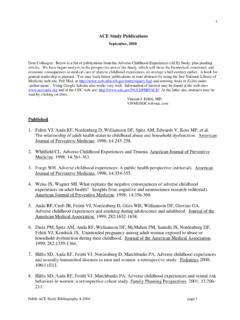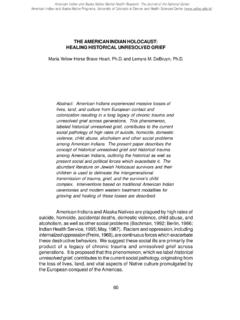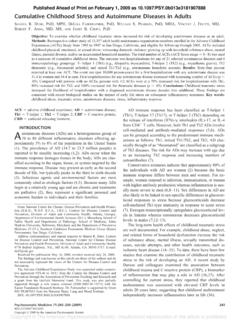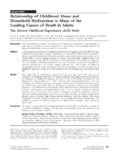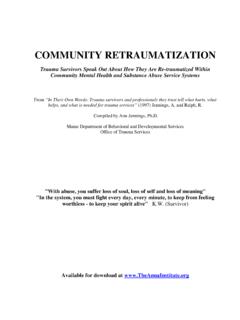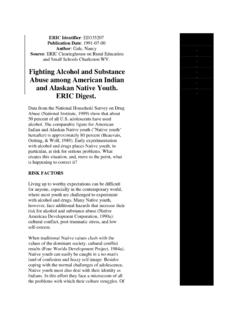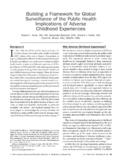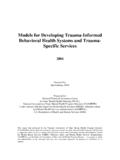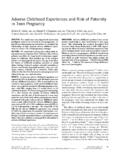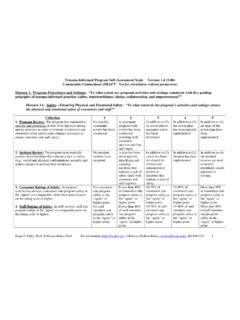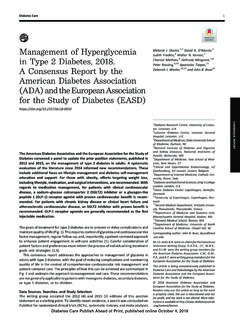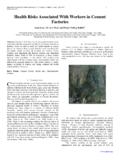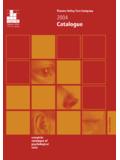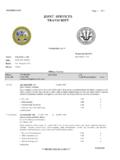Transcription of Adverse childhood experiences and hallucinations
1 Child Abuse & Neglect 29 (2005) 797 810 Adverse childhood experiences and hallucinationsCharles L. Whitfielda, Shanta R. Dubeb, , Vincent J. Felittic,Robert F. AndabaPrivate Practice in Addiction and Trauma Medicine, Atlanta, GA, USAbNational Center for Chronic Disease Prevention and Health Promotion, Centers for Disease Control and Prevention,Division of Adult and Community Health, 477 0 Buford Highway, , MS K-67, Atlanta, GA 3 0341-3717, USAcDepartment of Preventive Medicine, Southern California Permanente Medical Group,San Diego, CA, USAR eceived 3 October 2003; received in revised form 18 January 2005; accepted 22 January 2005 AbstractObjective:Little information is available about the contribution of multiple Adverse childhood experiences (ACEs)to the likelihood of reporting hallucinations . We used data from the ACE study to assess this :We conducted a survey about childhood abuse and household dysfunction while growing up, withquestions about health behaviors and outcomes in adulthood, which was completed by 17,337 adult HMO membersin order to assess the independent relationship of 8 Adverse childhood experiences and the total number of ACEs(ACE score) to experiencing hallucinations .
2 We used logistic regression to assess the relationship of the ACE scoreto self-reported :We found a statistically significant and graded relationship between histories of childhood trauma andhistories of hallucinations that was independent of a history of substance abuse. Compared to persons with 0 ACEs,those with 7 or more ACEs had a five-fold increase in the risk of reporting :These findings suggest that a history of childhood trauma should be looked for among persons with ahistory of hallucinations . 2005 Elsevier Ltd. All rights : hallucinations ; childhood trauma; Child abuse; Adverse childhood experiences Corresponding $ see front matter 2005 Elsevier Ltd. All rights Whitfield et al. / Child Abuse & Neglect 29 (2005) 797 810 IntroductionHallucinations are diagnostically nonspecific. Like fever, they alone are not pathognomonic for anydisorder. They may occur in several conditions and disorders, from the delirium of severe physical illnessand drug withdrawal to schizophrenia, bipolar disorder, and dissociative-identity disorder.
3 Researchershave found a significant association between hallucinations and childhood trauma (Chu & Dill, 1990;Ellenson, 1985; Ensink, 1992;Famularo, Kinscherff, & Fenton, 1992;Heins, Gray, & Tennant, 1990;Kennedy et al., 2002;Whitfield & Stock, 1996), but no studies have shown a graded relationship betweenexperiencing multiple forms of traumatic stress during childhood and these types of this study, we used data from the Adverse childhood experiences (ACE) study (Anda et al., 1999;Dube et al., 2001; Felitti et al., 1998) to examine the relationship of childhood trauma to a historyof hallucinations (the traumas included: abuse [emotional, physical, and sexual], witnessing domesticviolence, parental separation or divorce, and living with substance abusing, mentally ill, or incarceratedhousehold members as a child). Because the number of ACEs has repeatedly demonstrated a gradedrelationship to numerous health and social problems (Anda et al.)
4 , 2001;Anda, Chapman, et al., 2002;Anda, Whitfield, et al., 2002;Dietz et al., 1999;Dube et al., 2001;Dube, Anda, Felitti, Chapman, &Giles, 2003;Dube, Anda, Felitti, Edwards, & Croft, 2002;Felitti et al., 1998;Hillis, Anda, Felitti, &Marchbanks, 2001;Hillis, Anda, Felitti, Nordenberg, & Marchbanks, 2000;Whitfield, Anda, Dube, &Felitti, 2003) we determined whether the relationship of the total number of ACEs (ACE score: range0 8), to the risk of hallucinations was cumulative and graded. A statistical link between Adverse childhoodexperiences and hallucinations would suggest that a history of childhood exposure to traumatic stressshould be assessed among persons who report a history of hallucination. This information may helpclinicians to provide more effective treatment for victims of traumatic Adverse childhood experiences (ACE) study is collaboration between Kaiser Permanente s HealthAppraisal Center (HAC) in San Diego, and the Centers for Disease Control and Prevention.
5 The objectiveis to assess the impact of numerous Adverse childhood experiences on a variety of health behaviors andoutcomes, and health care utilization (Felitti et al., 1998). The ACE study was approved by the institutionalreview boards of Kaiser Permanente, Emory University and the Office of Protection from Research Risks,National Institutes of populationThe study population was drawn from the HAC, which provides complete and standardized medical,psychosocial, and preventive health evaluations to adult members of Kaiser Health Plan in San DiegoCounty. In any 4-year period, 81% of the adult membership obtains this service and over 50,000 membersare evaluated yearly; thus, HAC data represents the experiences and health status of a majority of adultKaiser members in San Diego. The San Diego membership contains a small percentage of MediCalpatients. Additionally, their HAC visits are primarily for complete health assessments rather than forsymptom or illness-based Whitfield et al.
6 / Child Abuse & Neglect 29 (2005) 797 810799 Persons evaluated at the HAC complete a standardized questionnaire that includes detailed healthhistories and health related behaviors, a medical review of systems, and psychosocial evaluations. Thisinformation was abstracted and is included in the ACE study study design and questionnaireThe baseline data collection was divided into two survey waves using the methodology describedbyFelitti et al. (1998). Two weeks after their HAC evaluation, each person was mailed an ACE studyquestionnaire, that asked for detailed information about Adverse childhood experiences ( , abuse andneglect), family and household dysfunction ( , domestic violence and substance abuse by parents orother household members), and questions about health related behaviors from adolescence to publications from the ACE study included respondents to Wave I (9,508/13,494; 70% response),conducted between August 1995 and March 1996.
7 Wave II (8,667/13,330; 65% response) was conductedbetween June and October 1997. Wave II added detailed questions about health topics that analysis ofWave I had shown to be important (Dube et al., 2003; Felitti et al., 1998). The combined response ratefor both survey Waves was 68% (18,175/26,824).Exclusions from the study cohortWe excluded 754 respondents who coincidentally underwent examinations during the time framesfor both survey waves, leaving 17,421 total respondents. After excluding 17 respondents with missingrace information and 67 with missing education information, the final study sample included 95% ofrespondents (17,337/18,175; Wave I = 8,708, Wave II = 8,629).Definitions of Adverse childhood experiencesAll ACE questions pertained to respondents first 18 years of life ( 18). For questions adapted fromthe conflict tactics scale (CTS;Straus & Gelles, 1990), response categories were never, once or twice, sometimes, often, or very often.
8 Emotional abuse was defined by two CTS questions: (1) How often did a parent,stepparent, or adult living in your home swear at you, insult you, or put you down? (2) How oftendid a parent, stepparent, or adult living in your home act in a way that made you afraid that you mightbe physically hurt? Responses of often or very often to either item defined emotional abuse abuse was defined by two CTS questions: Sometimes parents or other adultshurt children. How often did a parent, stepparent, or adult living in your home (1) push, grab, slap, or throwsomething at you? or (2) hit you so hard that you had marks or were injured? A respondent was definedas physically abused if the response was often, or very often to the first question or sometimes, often, or very often to the questions fromWyatt (1985)were adapted to define contact sexual abuse duringchildhood: Some people, while they are growing up in their first 18 years of life, had a sexual Whitfield et al.
9 / Child Abuse & Neglect 29 (2005) 797 810with an adult or someone at least 5 years older than themselves. These experiences may have involved arelative, family friend, or stranger. During the first 18 years of life, did an adult, relative, family friend,or stranger ever: (1) touch or fondle your body in a sexual way, (2) have you touch their body in a sexualway, (3) attempt to have any type of sexual intercourse with you (oral, anal, or vaginal) or (4) actuallyhave any type of sexual intercourse with you (oral, anal, or vaginal)? A yes response to any questionclassified a respondent as having experienced contact sexual abuse during used four CTS questions to define childhood exposure to a battered mother. Some-times physical blows occur between parents. How often did your father (or stepfather) or mother sboyfriend do any of these things to your mother (or stepmother)? (1) Push, grab, slap, or throw somethingat her, (2) kick, bite, hit her with a fist, or hit her with something hard, (3) repeatedly hit her over at leasta few minutes, or (4) threaten her with a knife or gun, or use a knife or gun to hurt her.
10 A response of sometimes, often, or very often to the first or second question or any response other than never to the third or fourth question defined a respondent as having had a battered substance questions asked whether respondents, during their childhood , livedwith a problem drinker, alcoholic (Shoenborn, 1995), or anyone who used street drugs. An affirmativeresponse to either question indicated childhood exposure to household substance illness in exposure to mentally ill household members was defined as a yes response to either of the following two questions. Was anyone in your household mentally ill ordepressed? and Did anyone in your household attempt to commit suicide? Parental separation or ACE was defined as a yes response to the question Were yourparents ever separated or divorced? Incarcerated household ACE was defined as having childhood exposure to a householdmember who was of alcohol or drug abuse among the respondentsDefinition of substance questions were used to define substance abuse among respondents:(1) Have you ever considered yourself to be an alcoholic?
